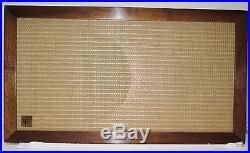
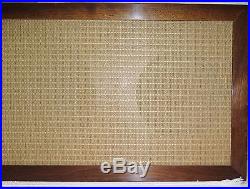
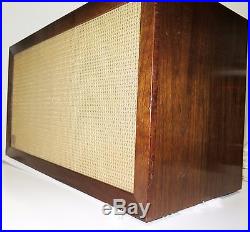
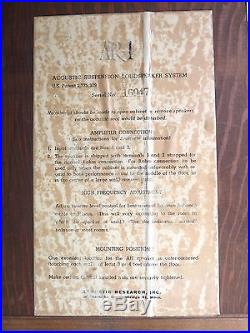
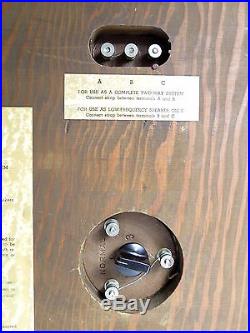

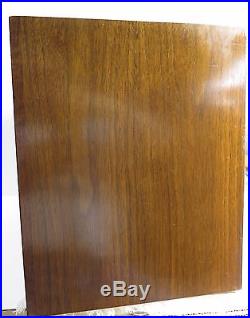
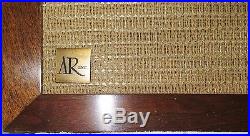
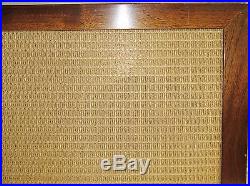
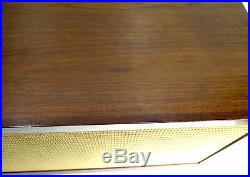
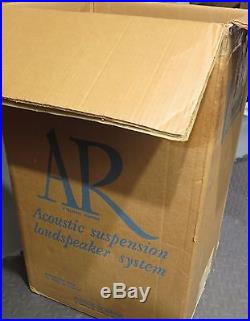
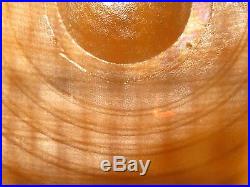

Acoustic Research AR-1 Loudspeaker, Single, Lacquered-Walnut Finish, SN 16947, EC. Specific AR-1W Item Description. This AR-1 loudspeaker is finished in a semi-gloss, piano-finish, lacquered-walnut, with serial number 16947, built in late 1957 or early 1958. This speaker is in exceptionally good condition with only minor cabinet scratches and marks. The bottom short side of the speaker shows signs of some small scratches, but otherwise, there are very few marks of any kind on this speaker, a true rarity for a lacquered-finish AR speaker that is nearly sixty years old. The grill cloth, with its golden threads woven through the off-white nylon/saran grill cloth, is nearly perfect with. Signs of dust lines or other issues. To find a grill that does not show dust outlines is unusual. The gold thread was used up through around 1962 in the AR-3 as well, and it is one of the most beautiful grill materials ever used on an AR loudspeaker. This grill color was slightly darker than the later ivory/white grills, and it is more of a light tan in color. Some of this is the age of the material, but AR did use several different tints of this saran grill material. The AR logo plate is in fine condition, showing no oxidation beneath the lacquer clear finish. This plate used AR’s specified “brushed” finish (I have the original specification and drawing for the design spec), and the logo looks fine. The grill-cloth molding, solid-walnut, has nearly perfect seams, whereas many AR speakers this old begin to crack and separate when they age. Small scratches were inevitable for this grade of finish, and this was Acoustic Research’s second type of lacquer finish from one of their many cabinet-makers over the years. For approximately ten years, AR used this very fine lacquer finishnearly identical to the process used by Steinway for their pianofor their semi-gloss lacquer finish. Prior to this, AR used lacquer finishes that were beautiful, but not nearly as smooth and flawless as this later method of finish. The raw wood on the earliest versions was not sanded, filled and sealed to the extent of the later versions. By the late 1960s, AR dropped all lacquer finishes due to the high cost of application and the fragility of the finish itself. Nothing is more beautiful than the lacquered-walnut or lacquered mahogany on AR-1s, AR-2s and AR-3s during the late 1950s and early 1960s. The woofer works perfectly with. Clean, undistorted deep-bass output. The excellent and durable 8-inch Altec Lansing 755A midrange/tweeter sound fine, as well, but the level control has become oxidized and it is sometimes difficult to find a clear point of contact. At some point, the level control will have to be cleaned. The balance in sound with the AR woofer and the Altec Lansing 755A is excellent, and this is well-known and respected throughout the world as being one of the premiere speaker systems. The input connections are nearly like new, and the product /serial-number label and input-connector instruction label on the back are in excellent condition without any paper being torn or missing. The knurled knobs and input plate are as new with no signs of wear. The label shows some cabinet stain bleed-through, but this was common when placing a label on stained wood. Acoustic Research AR-1 Technical History. To knowledgeable audiophiles and historians, the Acoustic Research AR-1 is well-known. From its commercial introduction in October 1954 at the New York Audio Fair, and. Throughout the next fifty+ years, it was considered to be one the. Low-frequency reproducers commercially available at. Certainly, any loudspeaker which might match the low-frequency capability of the AR acoustic-suspension woofer in smoothness and low distortion down at the lowest frequencies could not be easily lifted and would be several times the AR-1s size and weight. At its introduction in October 1958, the AR-1 immediately became the ultimate. In the high-fidelity industry with regard to low-distortion, low-frequency bass reproduction, and it cannot be overstated that the AR-1 12-inch woofer has never to this day been surpassed with regard to. Low distortion, smoothness and natural reproduction. Within its operating range. This woofer is nearly ruler flat, ±1.5 dB, from 38-1000 Hz. The AR-1 quickly gained fame during a 1956. New York Audio League. Test comparison between this woofer and the famous Klipsch. Corner-horn loudspeaker, a speaker known for its excellent low-frequency response and a behemoth loudspeaker that dwarfs the AR-1 in size and weight, but whichsurprisinglycannot begin to match the low-frequency performance of the diminutive AR-1 12-inch woofer at frequencies of 30Hz and below! Julian Hirsch described the AR-1’s remarkable performance in his report in the audio league’s publication. At the risk of getting a little ahead of ourselves, we can point out that at 25 cycles (Hz), and below, the’1% efficient’ AR-1 is actually more efficient than the 50% efficient Klipschorn. The latter gives up rather abruptly in the vicinity of 30 Hz and produces little fundamental energy, while the AR-1 can generate relatively undistorted fundamentals down to 20Hz and below. This is a remarkable achievement, considering that the Klipschorn was originally designed as a corner bass horn. Four AR-1 loudspeakers were used in the famous Mt. Kisco, New York Live- vs. Recorded organ demonstration, in which the large Aeolian-Skinner pipe organ was compared with four AR loudspeakers. Listeners could detect no differences in the deep-bass portion of the comparison. Physically, the AR 12-inch acoustic-suspension woofer is mounted with eight machine screws into a sealed (acoustically) and braced enclosure, the size which is exactly optimal for the 43 Hz resonance frequency, and the restoring force ratio is approximately 85% acoustic and 15% mechanical, far greater than the bulk of current consumer loudspeakers using the a/s design. This is one reason why the AR-1 has much lower harmonic distortion than nearly any current-design loudspeaker in a comparable size. This woofer has a large 9.6 lb Alnico-5 magnet assembly, cast-aluminum frame and a long-throw, 2-inch heavy copper voice coil with a linear excursion of 5/8-inch and a maximum excursion of nearly 1 inch. The Altec Lansing 755A is an 8-inch, 8-watt, 4-ohm, Alnico-magnet full-range driver chosen for the AR-1 in 1954 because of its. Midrange and treble reproduction. With few exceptions, it was best “tweeter” available at the time, despite its large-diameter cone (with decoupling). It begins to fall off in response above 13 kHz, and it does not have wide off-axis reproduction; but what it does well. Is reproduce music clearly and very naturally without calling attention to itself, and for this it has become legendary among speakers. The 755A was designed in the late 1940s by Western Electric, and the speaker enjoyed wide use through the years in both consumer and professional applications. The AR-1 speaker is approximately 0.7% efficient, meaning that an amplifier capable of at least 25-50 watts-per-channel is the. The AR-1 dimensions are 14 x 25 x 11-3/8. In a single carton; when double-boxed, the weight is closer to 62 lbs. Reproduction or copying of any of this material without the express permission of the writer is unlawful and prohibited. The item “Acoustic Research AR-1 Loudspeaker, Lacquered-Walnut Finish, SN 16947, EC” is in sale since Monday, October 17, 2016. This item is in the category “Consumer Electronics\Vintage Electronics\Vintage Audio & Video\Vintage Speakers”. The seller is “acoustic-research-inc” and is located in High Point, North Carolina. This item can be shipped worldwide.
- Brand: Acoustic Research,Inc.
- MPN: AR-1
- Model: AR-1 Lacquered Walnut
- Country/Region of Manufacture: United States

Incoming search terms:
- https://acousticresearchspeakers net/2016/10/acoustic-research-ar-1-loudspeaker-lacquered-walnut-finish-sn-16947-ec/